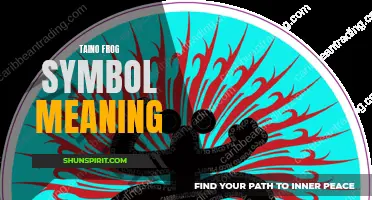
Symbols have always carried great significance and power in various cultures and societies, representing important ideas and concepts. One such symbol that holds immense importance is the symbol of new beginnings. Whether it is the rising sun, the phoenix, or the lotus flower, these symbols evoke a sense of hope, renewal, and transformation. Just like the changing of seasons or the dawn of a new day, these symbols remind us that life is cyclical, offering us endless opportunities to start afresh and embark on new beginnings. So, let us explore the world of symbols that represent new beginnings and unlock the hidden meaning within them.
What You'll Learn
- What are some common symbols that signify new beginnings?
- How do these symbols differ across different cultures and religions?
- Are there any specific symbols associated with new beginnings in the natural world?
- Do symbols of new beginnings often have historical or traditional significance?
- Can individuals create their own symbols to represent new beginnings in their personal lives?

What are some common symbols that signify new beginnings?
Throughout history and across cultures, certain symbols have been used to represent new beginnings. These symbols often have a deep meaning and are associated with hope, rebirth, and transformation. Here are some common symbols that signify new beginnings:
- The Phoenix: In Greek mythology, the phoenix is a mythical bird that is said to rise from its ashes. It symbolizes rebirth and new beginnings after a period of destruction or setback. The phoenix is often associated with immortality and the cycle of life.
- The Lotus Flower: In Buddhist and Hindu traditions, the lotus flower is a powerful symbol of spiritual awakening and enlightenment. It grows in muddy water and rises above the surface to bloom beautifully. The lotus represents purity, resilience, and new beginnings emerging from difficult circumstances.
- The Sunrise: The rising sun is often used as a symbol of new beginnings and the start of a new day. It represents hope, optimism, and the chance for a fresh start. The vibrant colors of a sunrise inspire a sense of renewal and possibilities.
- The Butterflies: Butterflies are often associated with transformation and metamorphosis. The process of a caterpillar becoming a butterfly symbolizes leaving behind the old and embracing a new phase of life. Butterflies are seen as a symbol of hope, change, and new beginnings.
- The Cross: In Christianity, the cross is a symbol of new life through Jesus Christ. It represents the resurrection and the promise of eternal life. The cross is often used to signify forgiveness, redemption, and a fresh start.
- The White Dove: The white dove is a symbol of peace, purity, and new beginnings. In Christian art, the dove is often depicted with an olive branch, signifying the end of a tumultuous time and the beginning of peace.
- The New Year's Eve/Day: The transition from one year to another is often seen as a symbol of new beginnings. New Year's Eve and New Year's Day symbolize the end of one chapter and the start of a fresh one. It is a time for reflection, goal-setting, and the opportunity to make positive changes in one's life.
Throughout history and across cultures, these symbols have been used to represent new beginnings and the hope that comes with them. Whether it be the mythical phoenix rising from its ashes, the beautiful lotus flower emerging from muddy waters, or the first light of a sunrise, these symbols remind us of the possibilities that lie ahead and the chance for a fresh start.
Unveiling the Profound Meanings of Kabbalah Symbols
You may want to see also

How do these symbols differ across different cultures and religions?
Symbols play a significant role in various cultures and religions around the world. These symbols are often laden with deep meaning and hold great importance to the communities that use them. While some symbols may have similar or even identical appearances across different cultures, their interpretations and significance can vary greatly. Let's explore how symbols differ across different cultures and religions.
One of the most widely recognized symbols is the cross. In Christianity, the cross symbolizes the crucifixion and resurrection of Jesus Christ, representing sacrifice, redemption, and salvation. However, in other cultures like ancient Egypt, the cross-like ankh symbolizes eternal life and fertility. Similarly, the Swastika, originally an ancient symbol of good luck and well-being, was adopted by the Nazis in Germany during World War II, giving it a completely different and negative connotation.
Another example is the lotus flower, which appears in various religions, including Buddhism and Hinduism. In Hinduism, the lotus represents purity and divine beauty, while in Buddhism, it symbolizes enlightenment and the ability to rise above obstacles. Both religions attribute different meanings to the same symbol, highlighting the importance of cultural context in interpreting symbols.
The yin and yang symbol, widely associated with Taoism, represents the duality and balance of opposing forces in the universe. It emphasizes the interdependence and interconnectedness of seemingly opposite entities. However, some cultures may interpret this symbol differently. For example, in Korean culture, the yin and yang symbol, known as the um and yang, represents the principles of duality and balance, but also includes the idea of cosmic energy flowing within everything.
In Native American culture, the dream catcher symbolizes protection from bad dreams and visions. It is believed to catch the bad dreams in its web while allowing good dreams to pass through. This symbol is unique to Native American culture and is not found in other religions or cultures.
Symbols like the star and crescent are associated with different religions. In Islam, the star and crescent symbolize the Islamic faith and is often depicted on the flags of Muslim-majority countries. In contrast, the star and crescent held different meanings in ancient civilizations like Mesopotamia, where they represented the moon god Sin and the sun goddess Ishtar, respectively. Here, the same symbols adopted new meanings as they spread across various cultures.
The importance of symbols and their interpretations can also vary within a single religion. In Christianity, for example, the Virgin Mary is depicted in different ways depending on cultural influences. In Western Christianity, the Virgin Mary is often depicted as a compassionate and nurturing mother. In contrast, in Eastern Orthodox Christianity, she is often portrayed as majestic and powerful, emphasizing her role as the Theotokos or Mother of God. These cultural differences can significantly impact the symbolism associated with religious figures.
In conclusion, symbols hold different meanings and interpretations across various cultures and religions. While some symbols may have universal associations, such as the cross representing sacrifice or the lotus symbolizing purity, other symbols can have divergent meanings based on cultural context. It is important to understand the cultural and religious significance of symbols to fully appreciate their deep-rooted messages and implications.
The Hidden Meanings Behind Symbolic Three Lines Tattoos Revealed
You may want to see also

Are there any specific symbols associated with new beginnings in the natural world?
In many cultures, the natural world is often attributed with symbolism representing new beginnings. From plants and animals to celestial bodies, there are various symbols associated with fresh starts and the concept of starting anew. These symbols hold significant meaning and are often used to represent new beginnings in different aspects of life.
One prominent symbol of new beginnings in the natural world is the butterfly. The butterfly undergoes a remarkable transformation from a caterpillar to a beautiful winged creature. This metamorphosis represents a complete change and rebirth, making it a powerful symbol of new beginnings. The butterfly's ability to emerge from its cocoon and take flight signifies the potential for personal growth and transformation in life.
Another natural symbol associated with new beginnings is the sunrise. The rising sun signals the start of a new day, representing a fresh start and the opportunity to begin again. The vibrant colors of a sunrise can also be interpreted as a metaphor for the beauty and possibilities that come with new beginnings. The moment the sun breaks the horizon is often viewed as a hopeful and promising event, symbolizing a bright future.
The cherry blossom, a delicate flower that blooms in spring, is also commonly associated with new beginnings. The cherry blossom is known for its ephemeral beauty and its ability to flourish after a long dormant period during winter. This cycle of blooming and shedding its petals represents the transient nature of life and the ever-present chance to start anew.
In addition to these symbolic representations from the natural world, there are also celestial symbols associated with new beginnings. One such symbol is the new moon. The new moon phase occurs when the moon is not visible from Earth, marking the beginning of a new lunar cycle. The dark sky during this phase is often associated with possibilities and fresh starts, making the new moon a symbol of new beginnings and new opportunities.
The natural world is rich with symbols that represent new beginnings. From the transformative journey of a butterfly to the vibrant colors of a sunrise, these symbols remind us that change and growth are constant in life. Whether through the blossoming of a cherry tree or the start of a new lunar cycle, the natural world offers us countless reminders that new beginnings are always possible, no matter the circumstances we find ourselves in. These symbols serve as powerful reminders of the innate potential for personal growth and transformation within each of us.
Understanding Mitsubishi Mirage Dashboard Symbols and Their Meanings
You may want to see also

Do symbols of new beginnings often have historical or traditional significance?
Symbols of new beginnings often hold historical or traditional significance in many cultures around the world. These symbols can be found in religious rituals, traditional ceremonies, and even in everyday life. They serve as powerful reminders of hope, renewal, and the opportunity for a fresh start.
One example of a symbol of new beginnings with deep historical and traditional significance is the lotus flower. In various Eastern religions, such as Buddhism and Hinduism, the lotus flower represents purity, enlightenment, and spiritual rebirth. It is often depicted as emerging from murky waters and blooming into a beautiful flower, symbolizing the journey from darkness to light and the possibility of personal growth and transformation.
In ancient Egypt, the scarab beetle held great symbolic value as a representation of rebirth and renewal. It was believed to be a manifestation of the sun god, Ra, and was often carved into amulets or used as a decorative motif in jewelry and other artifacts. The scarab beetle was associated with the idea of eternal life and was believed to possess the power to bring about new beginnings and protect against evil.
The phoenix is another powerful symbol of new beginnings that has a long history in mythology and folklore. The phoenix is a mythical bird that is said to be cyclically reborn from its own ashes. This bird represents the concept of death and resurrection, and is often associated with the sun and the cycles of nature. The phoenix symbolizes the ability to rise from the ashes of failure or destruction and start afresh with renewed strength and determination.
Symbols of new beginnings can also be found in everyday life, often rooted in cultural traditions and customs. For example, the blowing out of candles on a birthday cake is a widely recognized symbol of celebrating the start of a new year of life. Similarly, the act of throwing rice at weddings is a symbolic gesture meant to shower the newlyweds with blessings for a prosperous and fruitful beginning to their married life.
In conclusion, symbols of new beginnings often carry a rich historical or traditional significance. They serve as powerful reminders of the potential for growth, transformation, and renewal. From the lotus flower in Eastern religions to the scarab beetle in ancient Egypt, these symbols remind us of the universal hope for a fresh start and the opportunity to overcome adversity. They are a testament to the enduring human spirit and our belief in the power of new beginnings.
Decoding the Dark: Unraveling the Meaning Behind Bad Omens Band Symbols
You may want to see also

Can individuals create their own symbols to represent new beginnings in their personal lives?
Symbols have been used throughout history to represent various concepts, events, and emotions. From ancient civilizations to modern societies, symbols have played a significant role in human communication and expression. One such concept that symbols often represent is the idea of new beginnings.
New beginnings can refer to a range of changes in one's personal life, such as starting a new job, moving to a new city, or embarking on a new relationship. These transitions can be exciting, but they can also bring about feelings of uncertainty or apprehension. Creating personal symbols to represent these new beginnings can be a powerful way for individuals to embrace and celebrate these changes.
The act of creating personal symbols allows individuals to infuse their own meaning and significance into the representation of their new beginning. Symbols can be physical objects, drawings, or even gestures that hold personal significance. For example, someone starting a new job may choose to create a nameplate with their initials or a specific color that represents their aspirations and goals in their new role.
Creating these symbols can serve several purposes. Firstly, they offer a tangible representation of the individual's intentions and aspirations for their new beginning. This can act as a visual reminder and motivate them to stay focused and committed to their goals. Secondly, symbols can provide comfort and reassurance during times of uncertainty or doubt. They serve as a constant reminder of the individual's strength and ability to navigate through new challenges.
Additionally, personal symbols can also serve as a form of self-expression and reflection. By creating symbols that represent their new beginnings, individuals have the opportunity to express their unique experiences and emotions. This can be particularly helpful in processing and understanding their own feelings about the change they are going through.
It is important to note that the creation of personal symbols is a deeply individual and personal process. Each individual's symbol will hold different meanings and represent different aspects of their new beginnings. The key is to create something that resonates with their own values, aspirations, and emotions.
In conclusion, individuals can create their own symbols to represent new beginnings in their personal lives. These symbols serve as a visual reminder of their goals and aspirations, provide comfort during uncertain times, and allow for self-expression and reflection. Embracing this creative process can be a powerful tool in navigating the transitions and changes that come with new beginnings.
Decoding the Meanings of Chevy Trailblazer Warning Light Symbols
You may want to see also
Frequently asked questions
The butterfly is a commonly recognized symbol of new beginnings. As it goes through a transformative process from a caterpillar to a beautiful butterfly, it represents the idea of starting fresh and embracing change.
Yes, the sunrise is also often associated with new beginnings. As the sun rises each morning, it represents a new day and a fresh start. It symbolizes the opportunity to leave the past behind and start anew.
The lotus flower grows in muddy and murky waters before emerging beautifully on the surface. This process symbolizes the journey towards enlightenment and transformation. It represents the idea that even in challenging and difficult circumstances, new beginnings can arise.
In Chinese culture, the dragon is often associated with new beginnings. It is believed to bring good fortune and symbolizes power, strength, and transformation. The dragon is seen as an auspicious symbol that can bring positive change and new opportunities.
The seed is often seen as a symbol of new beginnings. It represents the potential for growth and transformation. Just as a seed holds the potential to become a beautiful plant or tree, a new beginning holds the potential for new opportunities and experiences.







